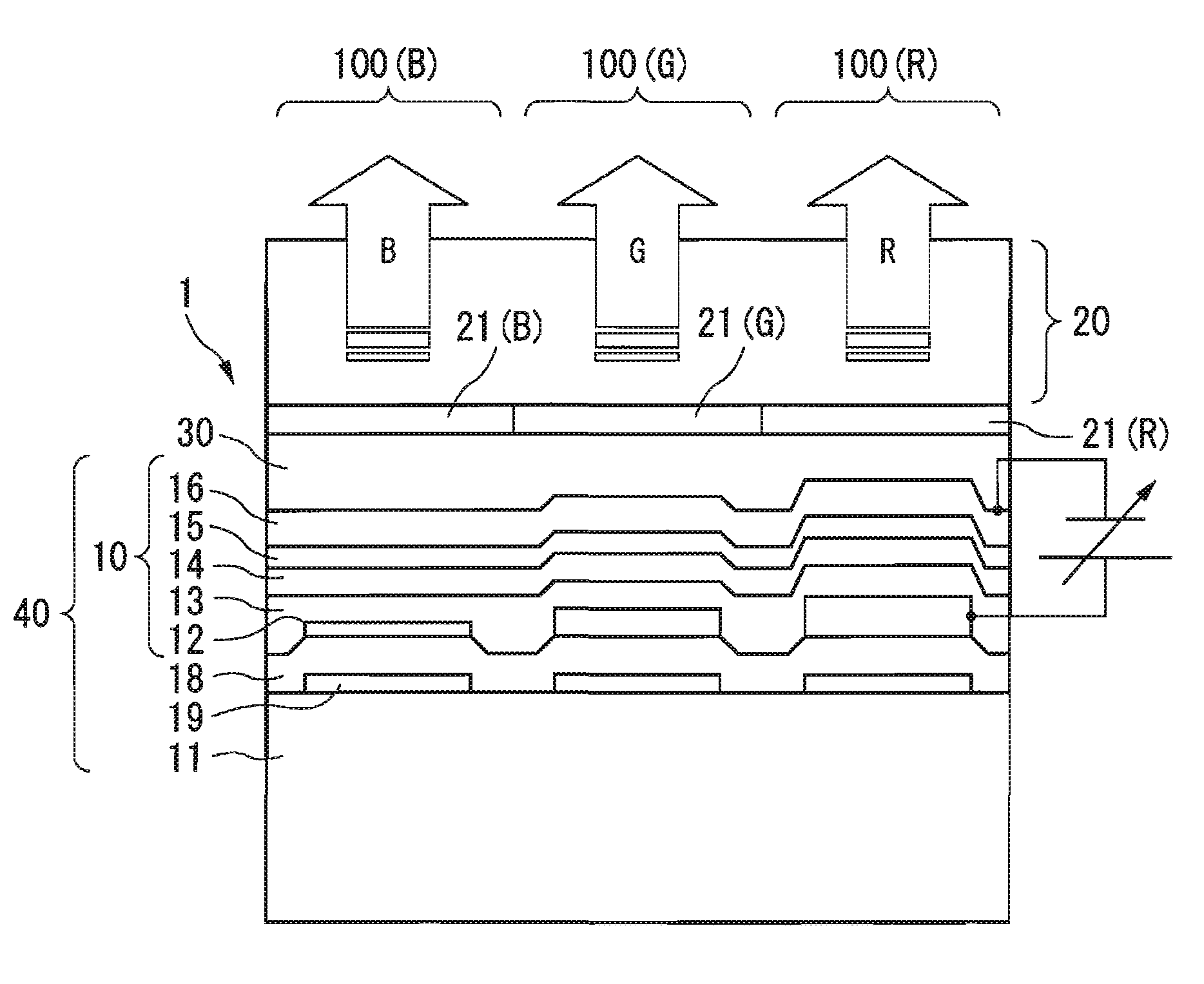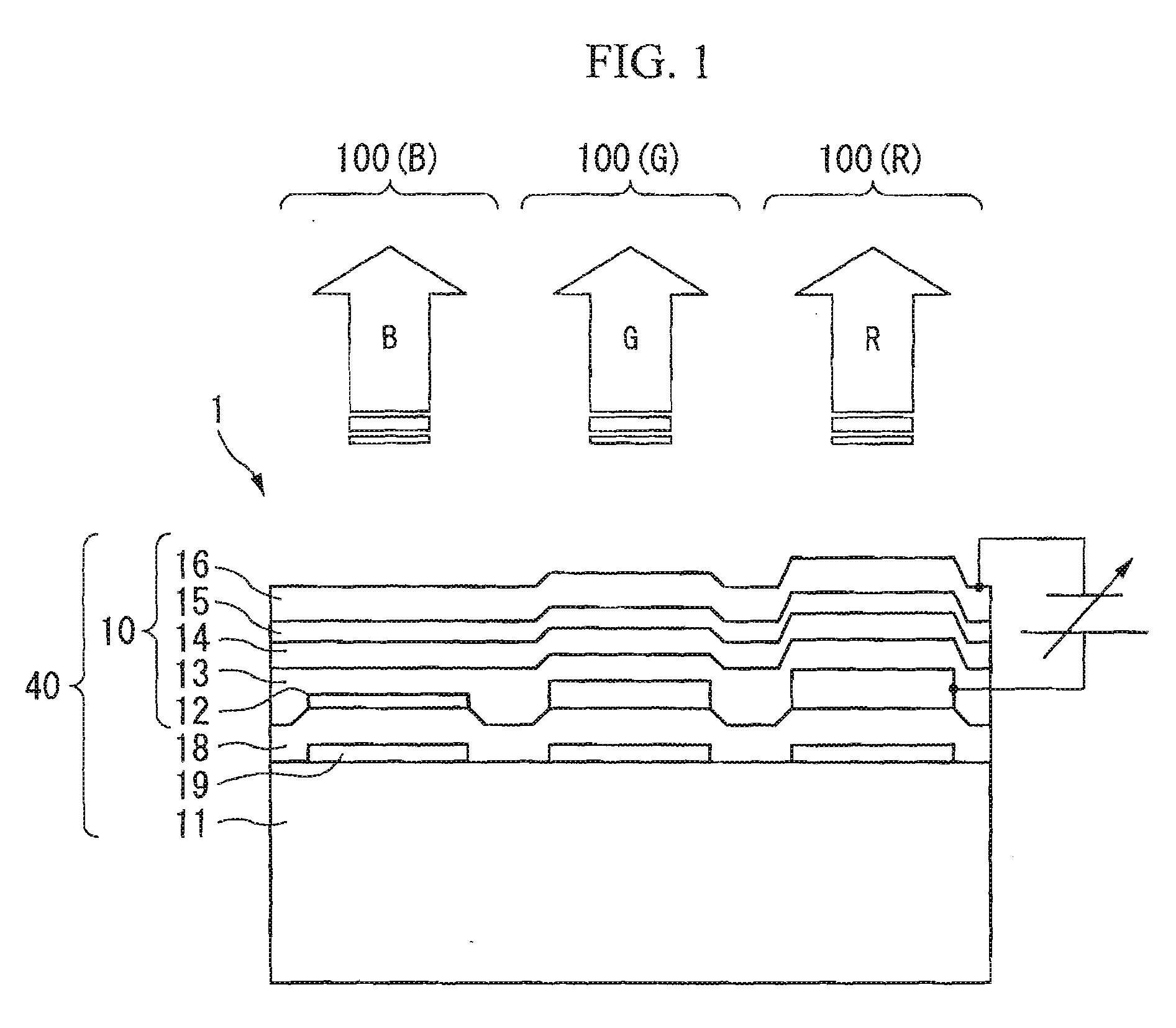Electroluminescence device, method of manufacturing electroluminescence device, and electronic apparatus
a technology of electroluminescence device and electroluminescence device, which is applied in the manufacture of electrode systems, electric discharge tubes/lamps, and discharge tubes luminescent screens, etc., can solve the problems of low reflection layer, low production efficiency, and low production efficiency, and achieve high display performance, easy formation of anodes, and high precision
- Summary
- Abstract
- Description
- Claims
- Application Information
AI Technical Summary
Benefits of technology
Problems solved by technology
Method used
Image
Examples
first embodiment
Basic Configuration of EL Device
[0101]FIG. 1 is a cross-sectional view schematically showing a configuration of an organic EL device (EL device) according to a first embodiment of the invention.
[0102] In FIG. 1, an organic EL device 1 according to the present embodiment is a too emission type device for emitting display light toward the opposite side of a substrate 11 when viewed from a light emitting layer 14. The organic EL device 1 has pixels 100(R), 100(G) and 100(B). The pixel 100(R) emits red (R) light, the pixel 100(G) emits green (G) light, and the pixel 100(B) emits blue (B) light. In the pixels 100(R), 100(G) and 100(B), an organic EL element 10 is formed.
[0103] The organic EL element 10 has a transparent anode 12 formed of indium tin oxide (ITO), a hole transport layer 13, a light emitting layer 14, an electron transport layer 15, and a cathode layer 16 formed of magnesium-silver alloy and having semitransparent reflectivity, all of which are laminated on the substrat...
second embodiment
[0147]FIG. 4 is a cross-sectional view schematically showing a configuration of an organic EL device (EL device) according to a second embodiment of the invention.
[0148] The organic EL device 1 shown in FIG. 4 is a top emission type device for emitting display light toward the opposite side of a substrate 11 when viewed from a light emitting layer 14. In the pixel 100(R) for emitting red (R) light, the pixel 100(G) for emitting green (G) light, the pixel 100(B) for emitting blue (B) light, an organic EL element 10 is formed. The organic EL element 10 has a transparent anode 12 formed of ITO, a hole transport layer 13, a light emitting layer 14, an electron transport layer 15, and a cathode layer 16 formed of magnesium-silver alloy and having semitransparent reflectivity, all of which are laminated on the substrate 11 formed of glass in that order.
[0149] A reflection layer 19 (total reflection layer) formed of aluminum, aluminum alloy, silver or silver alloy is formed between the s...
third embodiment
[0169] Next, an organic EL device (EL device) according to a third embodiment of the invention will be described.
[0170]FIG. 6 is a schematic diagram showing a wiring structure of an organic EL device according to the present embodiment. In FIG. 6, reference numeral 1 denotes the organic EL device.
[0171] The organic EL device 1 is an active matrix type using a thin film transistor (hereinafter, referred to as TFT) as a switching element, and has a wiring structure including a plurality of scan lines 101 . . . , a plurality of signal lines 102 . . . extending in a direction perpendicular to the scan lines 101, and a plurality of power source lines 103 . . . extending parallel to the signal lines 102. Pixels X . . . , are formed at the peripheries of intersections between the scan lines 101 . . . and the signal lines 102 . . . .
[0172] According to the technical spirit of the invention, the active matrix using the TFT is not necessarily required and a passive matrix substrate may be ...
PUM
 Login to View More
Login to View More Abstract
Description
Claims
Application Information
 Login to View More
Login to View More - R&D
- Intellectual Property
- Life Sciences
- Materials
- Tech Scout
- Unparalleled Data Quality
- Higher Quality Content
- 60% Fewer Hallucinations
Browse by: Latest US Patents, China's latest patents, Technical Efficacy Thesaurus, Application Domain, Technology Topic, Popular Technical Reports.
© 2025 PatSnap. All rights reserved.Legal|Privacy policy|Modern Slavery Act Transparency Statement|Sitemap|About US| Contact US: help@patsnap.com



